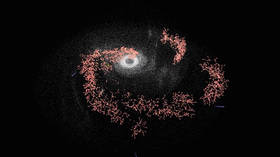Humans conquer Milky Way star by star in VIDEO simulation of galactic colonization

If humankind is ever threatened with a resource-scarcity apocalypse, a spectacular new simulation showcasing the most energy efficient strategy of colonizing the galaxy may be exactly what we need to survive.
While at first glance it might look like a laser show at a planetarium, the video is actually a sophisticated visual representation of the winning plan from the tenth annual Global Trajectory Optimization Competition (GOTC X) hosted by NASA Jet Propulsion Laboratory’s (JPL) Mission Design and Navigation section. The simulation was produced by a think tank from the European Space Agency (ESA).
The participants at GOTC X were tasked with reacting to a resource-crisis scenario set 10,000 years in the future. Although humans have developed the space travel technology allowing them to survive for generations while journeying to new star systems, instantaneous Star Trek style warp drive is still a way off.
Competitors therefore had to plot out a strategy to settle in “as many of the one hundred thousand star systems as possible, in as uniform a spatial distribution as possible, while using as little propulsive velocity change as possible,” starting out from a home star.
Also on rt.com US Air Force wants ‘patriotic’ private firms to share their satellites for NUCLEAR command & controlThe winners were a dream team made up of representatives from several Chinese research organizations. These groups included the College of Aerospace Science and Engineering; the National University of Defense Technology in Changsha; the State Key Laboratory of Astronautic Dynamics and the Xi’an Satellite Control Center.
Like this story? Share it with a friend!














